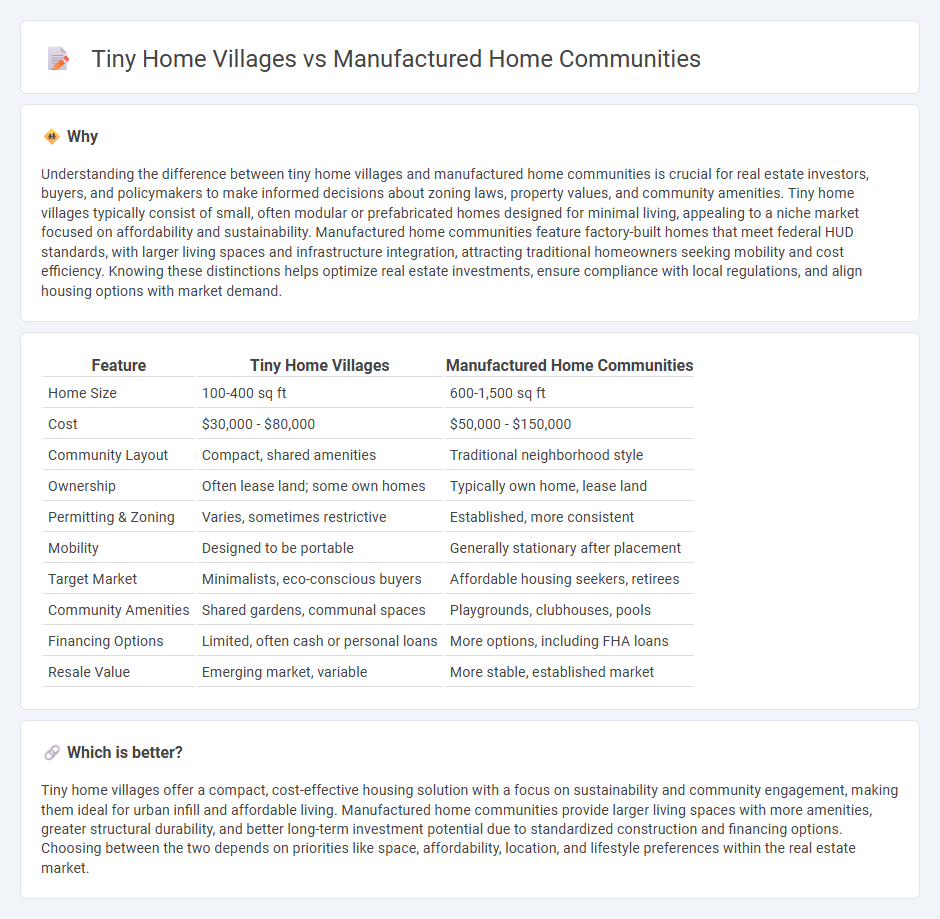
Tiny home villages offer compact, affordable living spaces that emphasize sustainability and community interaction, often located in urban or semi-urban settings. Manufactured home communities provide a range of prefabricated housing options with greater space and established infrastructure, catering to long-term residential needs. Discover the benefits and trade-offs between these innovative residential models to find the perfect fit for your lifestyle.
Why it is important
Understanding the difference between tiny home villages and manufactured home communities is crucial for real estate investors, buyers, and policymakers to make informed decisions about zoning laws, property values, and community amenities. Tiny home villages typically consist of small, often modular or prefabricated homes designed for minimal living, appealing to a niche market focused on affordability and sustainability. Manufactured home communities feature factory-built homes that meet federal HUD standards, with larger living spaces and infrastructure integration, attracting traditional homeowners seeking mobility and cost efficiency. Knowing these distinctions helps optimize real estate investments, ensure compliance with local regulations, and align housing options with market demand.
Comparison Table
| Feature | Tiny Home Villages | Manufactured Home Communities |
|---|---|---|
| Home Size | 100-400 sq ft | 600-1,500 sq ft |
| Cost | $30,000 - $80,000 | $50,000 - $150,000 |
| Community Layout | Compact, shared amenities | Traditional neighborhood style |
| Ownership | Often lease land; some own homes | Typically own home, lease land |
| Permitting & Zoning | Varies, sometimes restrictive | Established, more consistent |
| Mobility | Designed to be portable | Generally stationary after placement |
| Target Market | Minimalists, eco-conscious buyers | Affordable housing seekers, retirees |
| Community Amenities | Shared gardens, communal spaces | Playgrounds, clubhouses, pools |
| Financing Options | Limited, often cash or personal loans | More options, including FHA loans |
| Resale Value | Emerging market, variable | More stable, established market |
Which is better?
Tiny home villages offer a compact, cost-effective housing solution with a focus on sustainability and community engagement, making them ideal for urban infill and affordable living. Manufactured home communities provide larger living spaces with more amenities, greater structural durability, and better long-term investment potential due to standardized construction and financing options. Choosing between the two depends on priorities like space, affordability, location, and lifestyle preferences within the real estate market.
Connection
Tiny home villages and manufactured home communities share a focus on affordable, efficient housing solutions designed to maximize limited space while fostering a sense of community. Both models utilize prefabricated construction methods to reduce costs and expedite development, addressing the demand for sustainable living options. The integration of shared amenities and communal spaces in these communities enhances social interaction and supports residents' well-being.
Key Terms
Zoning Regulations
Manufactured home communities benefit from established zoning classifications that often allow for higher density and infrastructure support, facilitating easier compliance with local regulations. Tiny home villages face more complex zoning challenges due to their unique size and usage, frequently requiring special permits or variances to operate legally. Explore the specific zoning requirements to understand which option aligns better with your development goals.
Land Lease Agreements
Land lease agreements in manufactured home communities typically involve long-term leases with fixed costs, providing residents stability and ownership of their homes but not the land. Tiny home villages often feature more flexible, shorter-term land leases that accommodate a transient lifestyle and encourage communal living, yet may lack the security found in traditional manufactured home setups. Explore further to understand how these lease structures impact affordability and resident rights.
Community Amenities
Manufactured home communities often feature extensive amenities such as clubhouses, swimming pools, playgrounds, and fitness centers, enhancing residents' social and recreational experiences. Tiny home villages typically prioritize shared green spaces, communal gardens, and multi-use gathering areas that foster close-knit interactions and sustainable living. Explore the unique community amenities each offers to find the best fit for your lifestyle preferences.
Source and External Links
Manufactured Housing Communities in the U.S. - MHI - There are more than 43,000 manufactured home communities in the U.S., representing almost 4.3 million homesites, providing financial and lifestyle benefits through land-lease communities.
Supporting Manufactured Home Communities - Roughly 40% of manufactured homes are in communities where residents own their homes but rent the land, with some communities becoming resident-owned to secure control and protections for homeowners.
Manufactured Home Communities For All Ages and 55+ - Manufactured home communities offer affordable, factory-built single-family homes on leased land with community amenities and cater to families and 55+ residents.
 dowidth.com
dowidth.com